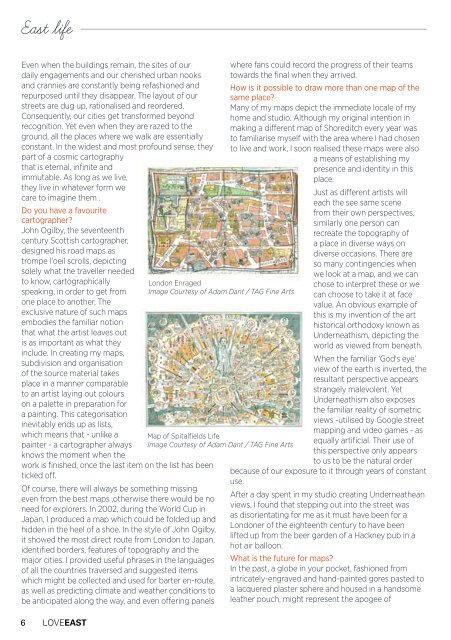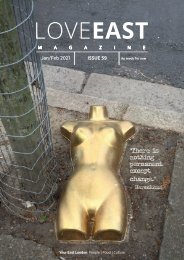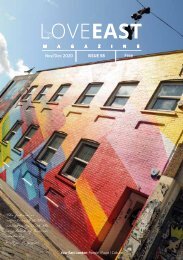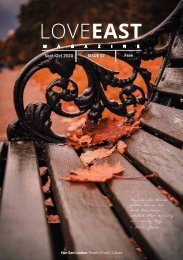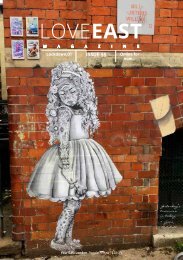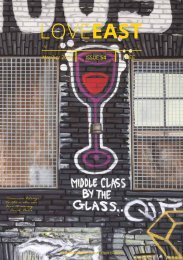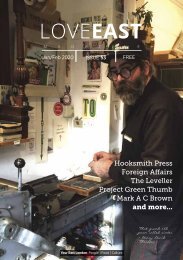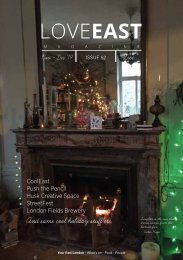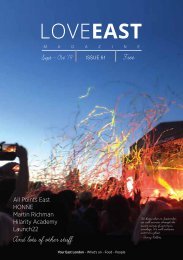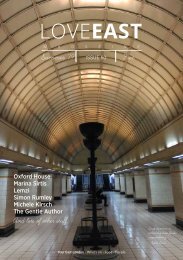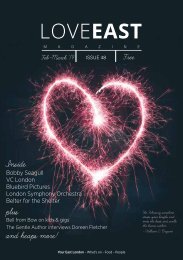LoveEast.46
Create successful ePaper yourself
Turn your PDF publications into a flip-book with our unique Google optimized e-Paper software.
East life<br />
Even when the buildings remain, the sites of our<br />
daily engagements and our cherished urban nooks<br />
and crannies are constantly being refashioned and<br />
repurposed until they disappear. The layout of our<br />
streets are dug up, rationalised and reordered.<br />
Consequently, our cities get transformed beyond<br />
recognition. Yet even when they are razed to the<br />
ground, all the places where we walk are essentially<br />
constant. In the widest and most profound sense, they<br />
part of a cosmic cartography<br />
that is eternal, infinite and<br />
immutable. As long as we live,<br />
they live in whatever form we<br />
care to imagine them .<br />
Do you have a favourite<br />
cartographer?<br />
John Ogilby, the seventeenth<br />
century Scottish cartographer,<br />
designed his road maps as<br />
trompe l'oeil scrolls, depicting<br />
solely what the traveller needed<br />
to know, cartographically<br />
speaking, in order to get from<br />
one place to another. The<br />
exclusive nature of such maps<br />
embodies the familiar notion<br />
that what the artist leaves out<br />
is as important as what they<br />
include. In creating my maps,<br />
subdivision and organisation<br />
of the source material takes<br />
place in a manner comparable<br />
to an artist laying out colours<br />
on a palette in preparation for<br />
a painting. This categorisation<br />
inevitably ends up as lists,<br />
which means that - unlike a<br />
painter - a cartographer always<br />
knows the moment when the<br />
work is finished, once the last item on the list has been<br />
ticked off.<br />
Of course, there will always be something missing<br />
even from the best maps ,otherwise there would be no<br />
need for explorers. In 2002, during the World Cup in<br />
Japan, I produced a map which could be folded up and<br />
hidden in the heel of a shoe. In the style of John Ogilby,<br />
it showed the most direct route from London to Japan,<br />
identified borders, features of topography and the<br />
major cities. I provided useful phrases in the languages<br />
of all the countries traversed and suggested items<br />
which might be collected and used for barter en-route,<br />
as well as predicting climate and weather conditions to<br />
be anticipated along the way, and even offering panels<br />
6 LOVEEAST<br />
London Enraged<br />
Image Courtesy of Adam Dant / TAG Fine Arts<br />
Map of Spitalfields Life<br />
Image Courtesy of Adam Dant / TAG Fine Arts<br />
where fans could record the progress of their teams<br />
towards the final when they arrived.<br />
How is it possible to draw more than one map of the<br />
same place?<br />
Many of my maps depict the immediate locale of my<br />
home and studio. Although my original intention in<br />
making a different map of Shoreditch every year was<br />
to familiarise myself with the area where I had chosen<br />
to live and work, I soon realised these maps were also<br />
a means of establishing my<br />
presence and identity in this<br />
place.<br />
Just as different artists will<br />
each the see same scene<br />
from their own perspectives,<br />
similarly one person can<br />
recreate the topography of<br />
a place in diverse ways on<br />
diverse occasions. There are<br />
so many contingencies when<br />
we look at a map, and we can<br />
chose to interpret these or we<br />
can choose to take it at face<br />
value. An obvious example of<br />
this is my invention of the art<br />
historical orthodoxy known as<br />
Underneathism, depicting the<br />
world as viewed from beneath.<br />
When the familiar ‘God's eye’<br />
view of the earth is inverted, the<br />
resultant perspective appears<br />
strangely malevolent. Yet<br />
Underneathism also exposes<br />
the familiar reality of isometric<br />
views -utilised by Google street<br />
mapping and video games - as<br />
equally artificial. Their use of<br />
this perspective only appears<br />
to us to be the natural order<br />
because of our exposure to it through years of constant<br />
use.<br />
After a day spent in my studio creating Underneathean<br />
views, I found that stepping out into the street was<br />
as disorientating for me as it must have been for a<br />
Londoner of the eighteenth century to have been<br />
lifted up from the beer garden of a Hackney pub in a<br />
hot air balloon.<br />
What is the future for maps?<br />
In the past, a globe in your pocket, fashioned from<br />
intricately-engraved and hand-painted gores pasted to<br />
a lacquered plaster sphere and housed in a handsome<br />
leather pouch, might represent the apogee of


